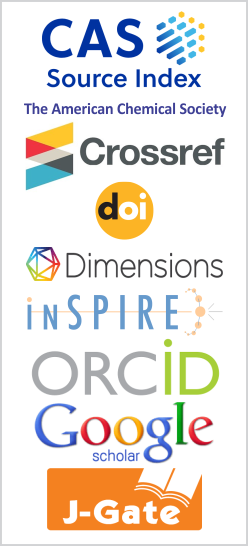Photoluminescence Properties of (Mg\(^{2+}\)) Divalent and (Al\(^{3+}\)) Trivalent Metal Coumarinolates Doped with Quinoline for PCLED Application
DOI:
https://doi.org/10.26713/jamcnp.v9i1.1961Keywords:
Di-coumarinolates, Tri-coumarinolates, PCLED applicationAbstract
Several Mg-Coumarinolates and Al-Coumarinolates doped with different concentrations of Quinoline were synthesized by simple chemical synthesis method and their PL spectra were studied. Usually, pure coumarin along with the chelates show weak luminescence and the emission is witnessed around 450 nm with excitation around 350 nm. Hence, such chelates do not find any practical applications. Addition of quinoline in lesser amount affects the emission and excitation of Mg-Coumarin and Al-Coumarin considerably. Intense photoluminescence is observed in these Mg based mixed chelates. In all samples, a well-defined emission band at 490 nm is observed with broad excitation in 350 nm to 470 nm range. Hence good overlap of excitation with 420 nm and 440 nm LED emission makes these materials suitable for white LED applications.
Downloads
References
Z.H. Abd El-Wahab, M.M. Mashaly, A.A. Salman, B.A. El-Shetary and A.A. Faheim, Co(II), Ce(III) and UO2(VI) bis-salicylatothiosemicarbazide complexes: Binary and ternary complexes, thermal studies and antimicrobial activity, Spectrochimica Acta Part A: Molecular and Biomolecular Spectroscopy 60(12) (2004), 2861 – 2873, DOI: 10.1016/j.saa.2004.01.021.
M.-T. Alonso, E. Brunet, O. Juanes and J.-C. Rodrıguez-Ubis, Synthesis and photochemical properties of new coumarin-derived ionophores and their alkaline-earth and lantanide complexes, Journal of Photochemistry and Photobiology A: Chemistry 147(2) (2002), 113 – 125, DOI: 10.1016/S1010-6030(01)00628-1.
V. Aravindan, J. Gnanaraj, S. Madhavi and H.-K. Liu, Lithium-ion conducting electrolyte salts for lithium batteries, Chemistry – A European Journal 17(51) (2011), 14326 – 14346, DOI: 10.1002/chem.201101486.
K.B. Gudasi, R.V. Shenoy, R.S. Vadavi, M.S. Patil and S.A. Patil, Synthesis, characterisation and biological evaluation of lanthanide (III) complexes with 3-Acetylcoumarin-o-aminobenzoylhydrazone (ACAB), Chemical and Pharmaceutical Bulletin 53(9) (2005), 1077 – 1082, DOI: 10.1248/cpb.53.1077.
M.V. Hathi, K.B. Vyas, K.S. Nimavat and G.R. Jani, Synthesis, characterization and pH metric study of some novel metal complexes, International Journal of Chemical Sciences 7(3) (2009), 2103 – 2107, URL: https://www.tsijournals.com/articles/synthesis-characterization-and-ph-metric-study-of-some-novel-metal-complexes.pdf.
S. Jayasree and K.K. Arvindakshan, Structural and antitumour studies of metal complexes with thiosemicarbazones of β-diketoesters, Polyhedron 12(10) (1993), 1187 – 1192, DOI: 10.1016/S0277-5387(00)88210-8.
H.-K. Kim, J.-B. Oh, N.-S. Baek, S.-G. Roh, M.-K. Nah and Y.-H. Kim, Recent progress in luminescent lanthanide complexes for advanced photonics applications, Bulletin of the Korean Chemical Society 26(2) (2005), 201 – 214, DOI: 10.5012/bkcs.2005.26.2.201.
I.P. Kostova, I. Manolov and M.K. Radulova, Stability of the complexes of some lanthanides with coumarin derivatives. II. Neodymium(III)-acenocoumarol, Acta Pharmaceutica 54(2) (2004), 119 – 131, URL: https://hrcak.srce.hr/16819
I.P. Kostova, I.I. Manolov and M.K. Radulova, Stability of the complexes of some lanthanides with coumarin derivatives. I. Cerium(III)-4-methyl-7-hydroxycoumarin, Acta Pharmaceutica 54(1) (2004), 37 – 47, URL: https://hrcak.srce.hr/clanak/25406.
D.C. Manvar, D. Karia and A. Shah, Synthesis and anti-HIV activity of some 3-acetyl/aceto acetyl-4-hydroxy benzopyran-2-ones: An invitro evaluation, Indian Journal of Organic Chemistry 3 (2007), 170, URL: https://www.tsijournals.com/abstract/synthesis-and-antihiv-activity-of-some-3acetylacetoacetyl4hydroxy-benzopyran2ones-an-in-vitro-evaluation-3776.html.
V.V. Mulwad and R.D. Bhagat, Synthesis of some pyranobenzopyrans and 3-styryl 4H(1) benzopyran[3,4-d] isoxazoles I, Indian Journal of Heterocyclic Chemistry 9 (1999), 15.
R.C. Sharma and R.K. Parashar, Synthesis and microbicidal activity of N-(2-substituted) phenyl ureas and their metal complexes, Journal of Inorganic Biochemistry 32(3) (1988), 163 – 169, DOI: 10.1016/0162-0134(88)80024-2.
A. Singh and P. Singh, Synthesis, characterization and antiinflammatory effects of Cr(III), Mn(II), Fe(III) and Zn(II) complexes with diclofe nac sodium, Indian Journal of Chemistry 39 A (2000), 874, URL: http://nopr.niscair.res.in/handle/123456789/15479.
B. Thati, A. Noble, B.S. Creaven, M. Walsh, M. McCann, M. Devereux, K. Kavanagh and D.A. Egan, Role of cell cycle events and apoptosis in mediating the anti-cancer activity of a silver(I) complex of 4-hydroxy-3-nitro-coumarin-bis(phenanthroline) in human malignant cancer cells, European Journal of Pharmacology 602(2-3) (2009), 203 – 214, DOI: 10.1016/j.ejphar.2008.11.020.
L. Wu, X. Wang, W. Xu, F. Farzaneh and R. Xu, The structure and pharmacological functions of coumarins and their derivatives, Current Medicinal Chemistry 16(32) (2009), 4236 – 4260, DOI: 10.2174/092986709789578187.
Downloads
Published
How to Cite
Issue
Section
License
Authors who publish with this journal agree to the following terms:- Authors retain copyright and grant the journal right of first publication with the work simultaneously licensed under a CCAL that allows others to share the work with an acknowledgement of the work's authorship and initial publication in this journal.
- Authors are able to enter into separate, additional contractual arrangements for the non-exclusive distribution of the journal's published version of the work (e.g., post it to an institutional repository or publish it in a book), with an acknowledgement of its initial publication in this journal.
- Authors are permitted and encouraged to post their work online (e.g., in institutional repositories or on their website) prior to and during the submission process, as it can lead to productive exchanges, as well as earlier and greater citation of published work.




